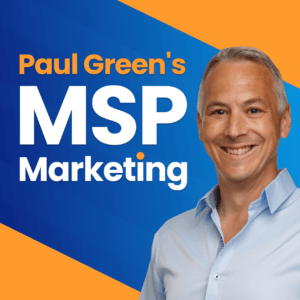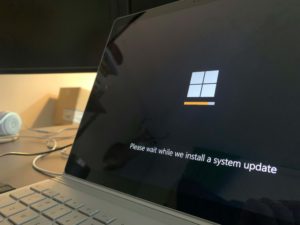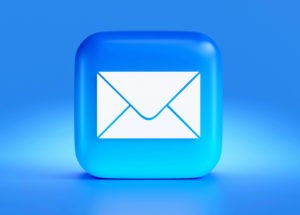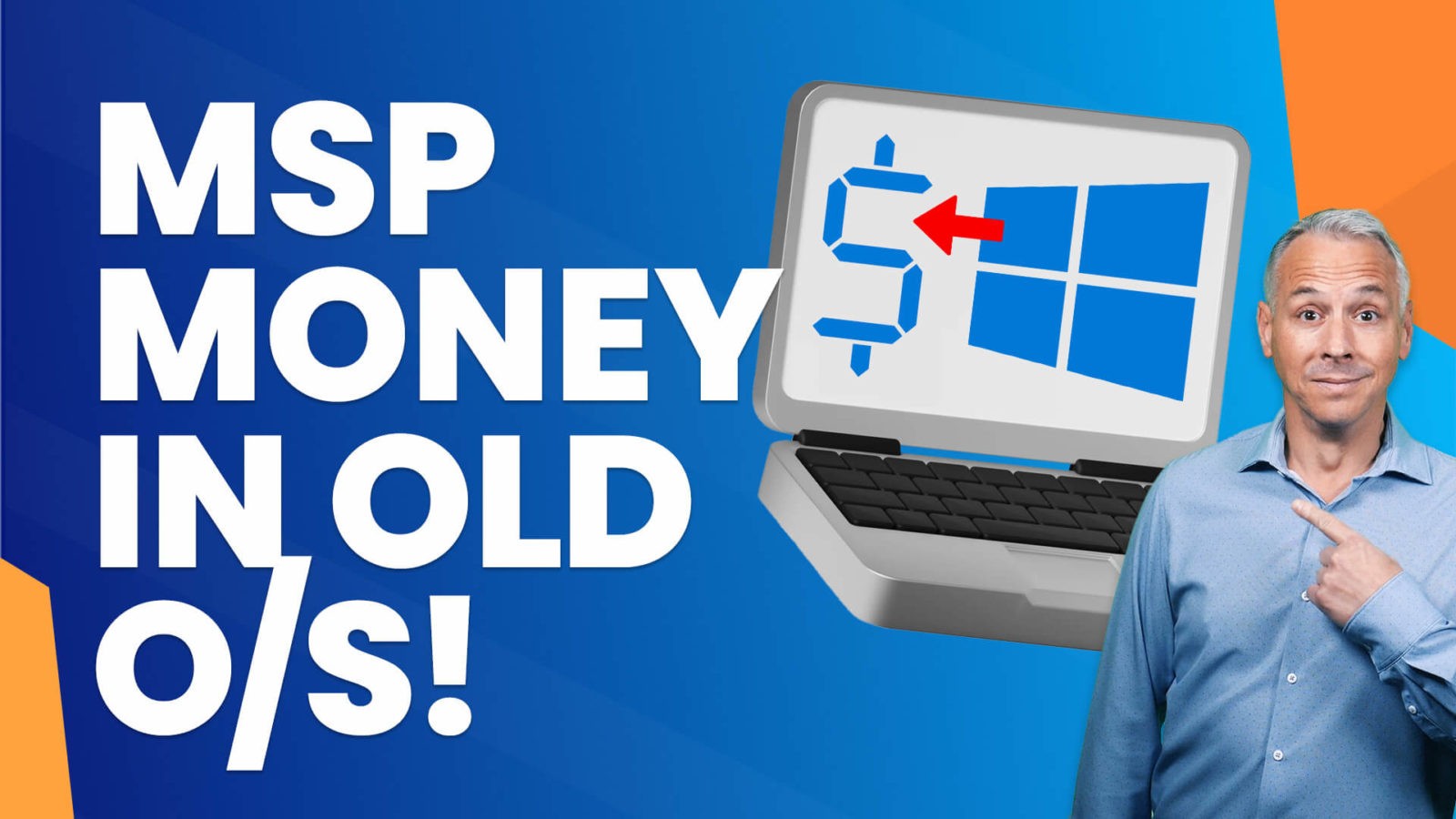
The podcast powered by the MSP Marketing Edge
Welcome to Episode 287 of the MSP Marketing Podcast with me, Paul Green. This week…
- Great marketing for Windows 10 end of life: There’s a hot new opportunity – Windows 10. This soon to be obsolete operating system is good for your MSP with this end of life marketing opportunity.
- Ask this cybersecurity question to speed past phone gatekeepers: Most MSPs really struggle to reach the person they want to speak to. This trick will help you get past the gatekeeper and start a much more productive conversation.
- Can you drive new revenue with DMARC?: DMARC isn’t just critical for ensuring messages reach people’s inboxes, my guest believes that DMARC can actually generate new leads and new revenue for your MSP.
- Paul’s Personal Peer Group: This week’s question is about getting more attention and engagement by adding personalised videos to emails. Find out which software options are available for this.
Great marketing for Windows 10 end of life
So you’re an MSP trying to find new clients and also increase revenue from your existing clients. Well tell me, have you heard about the hot new opportunity – Windows 10? Yeah, you heard that, right? But how could talking about an old, soon to be obsolete operating system be good for your MSP? Is this a credible way to win new clients or upsell your existing clients? Let’s find out about the Windows 10 end of life marketing opportunity.
Five months. That’s what we’ve got until Windows 10 reaches its end of life and it’s been with us a decade you know, it first launched in 2015. Will you be sad to see it go or are you already a big fan of Windows 11? Anyway, that’s kind of irrelevant to this conversation, and I know that loads of MSPs still miss XP. I’m kind of joking there, although do you?
But what we’re talking about here is using Windows 10 as a marketing opportunity, not only to win new clients but also to upsell your existing clients. You see anytime there’s a big enforced change in the marketplace, like a major operating system reaching its end of life, that creates an opportunity for you. And one of the key things in marketing is always putting yourself in the shoes of the person that you are trying to reach and influence.
For an ordinary business owner or manager, Windows 10 reaching its end of life is going to be a bit of a shock to them in October.
Not for you and me, they announced the 2025 end of life date four years ago can you believe. But what’s big in our world and surrounds us every day does not surround ordinary business owners and managers. And you and I both know that there will be many, many people running their businesses on Windows 10 with no idea that this is coming. And maybe their MSP or their break/fix outfit has told them, but they weren’t listening or they’ve ignored it and ignored it and ignored it, and then suddenly it’s October 2025 and it’s crept up on them.
So what’s the best way to tackle this for prospects and for existing clients? Well, let’s look at those separately. And the easiest way to start is with the prospects. Now, I’m guessing you as an MSP have a preferred route forward at this point, in terms of what to do after Windows 10. So many MSPs will want their clients to upgrade to Windows 11. I do know a few MSPs that are still trying to hang on to Windows 10, and let’s not get into a technical conversation about that because that’s not really what this podcast is for. But I guess for your existing clients who are still on Windows 10, their routes forward are either upgrading to Windows 11 or of course paying for the extended security updates.
I truly believe that as their MSP it’s down to you to educate them about their choice and the pros and cons of each one. Then give them a recommendation based on your relationship with them and what you think is going to be best for them. Now, this will be a great time to set up meetings with your existing clients to actually have that conversation. And there’s no point leaving it till September as suddenly everything becomes a rush and an emergency if they want to get off Windows 10 before it reaches end of life.
At this time of year with a roundabout five months to go, I would book yourself either Zooms or real life meetings with your existing clients to review how many devices they’ve got that are still running Windows 10. And obviously you’re going to know that in advance if you’re all over your asset management, but I would have that conversation with them now. And yes, that could generate some nice project work for you, but the bigger picture is that you are helping your client to stay ahead of the curve.
If they insist on staying with Windows 10 and paying for the extended security updates, as frustrating as that might be for you, that’s up to them. And I’m sure you have a very clear opinion about how that’s going to affect your relationship and the level of support that you’re able to offer to them in the next couple of years. But the key thing with any conversation like this that you are having with existing clients is about protecting the long-term relationship, and making sure that your client is happy and well protected so that they will still be with you in 10 years time. That’s the most important thing.
Let’s talk about using this change to win new clients. I believe it’s a similar opportunity in terms of educating people about the pros and cons. Although because you don’t have a working relationship yet with new clients, with people who are prospects today, you would go about it differently. So let me tell you what we’ve done in our MSP Marketing Edge service because that might give you some ideas.
We’ve put together a whole bunch of materials which we actually delivered to our members just a few days ago. And those materials are designed to help them catch the attention of leads and prospects and educate them about what’s happening and what the implications are of the end of life of Windows 10. So we put together a full educational guide. There’s a video, there’s a whole email sequence, there’s some social media content, there’s a postcard which can be sent out in the mail and a full direct mail and a multi-step follow-up sequence. That seems like a lot when you put it all together in one box like that, but my goal when putting this together with my team was to give our members the flexibility of lots and lots of different materials that they can choose from.

The important thing now is that they work their audiences that they’ve built up and get these materials in front of them, and that’s their audiences of leads and prospects as well as their existing clients. So they should be putting stuff about Windows 10 onto LinkedIn, sending out messages on LinkedIn, sending out emails, and especially shipping stuff in the mail to prospects whose addresses they have. And let’s be honest, it’s super easy to find any prospects address these days. Because if you remember the context that the average business owner or manager is not aware of this, it’s not on their radar, and therefore they’re not going to take action, this is a potentially massive opportunity for you.
This change is coming whether they like it or not. So really as the educator, as the expert, the local tech authority, you should jump on this and educate as many local business owners and managers as you can. And sure a ton of them are still going to leave their head in the sand and they’re not going to listen to you or any other MSP talking about this. But for some who suddenly notice that the technology that they run their entire business on is going to be obsolete from October, that will trigger some of them to want to do something about it. And they’re very likely to want to do that with the person that’s educated them, which should be you.
Tell me, are you in the 1% club. The 1% of MSPs who actually enjoy calling leads and prospects on the phone trying to find new business? Are you, no?
Alright, well therefore I take it you’re in the 99% of MSPs that really struggle with this because for many it’s about the hell of getting past the gatekeeper. That person who seems to take enormous pleasure in stopping you getting through to the person you really want to speak to.
But yes, it is possible to fix this to get through, past the gatekeeper most of the time. And it’s all thanks to cybersecurity.
Let’s find out how one cybersecurity question can get you past the gatekeeper and start a much more productive conversation.

This is short and super simple. When you phone people and you’re trying to get past the gatekeeper to speak to the decision maker, do not say the classic old line, Who’s responsible for your IT? Don’t say that. They have heard that a hundred or a thousand times before. And when they’ve heard something many times before, it’s very easy for them to fob you off, say that person’s not in, lie and fib and ultimately end the call. So instead say this, Who’s responsible for your cybersecurity?
I can pretty much guarantee they won’t have heard that one before. And when they haven’t heard something, it’s going to make them pause and then start to think. And I reckon that you’ll stand a better chance of getting through to someone with that question. So here it is again. Write this one down, use this one whenever anybody in your MSP is calling any lead or prospect. Who’s responsible for your cybersecurity?
Do try that one out, won’t you? And let me know how you get on. Oh, and if you are in that 1% club and you already phone leads and you love doing that, will you also let me know? What do you say to get past the gatekeeper?
Can you drive new revenue with DMARC?

Featured guest: Taylor Tabusa has spent over a decade in the email space, focusing on email delivery and authentication. And while that’s the case his path to cybersecurity and MSPs was not a straight line. Originally a winemaker, he spent years in Napa and Australia before pivoting into tech. After helping build and sell a recruiting software company that relied on email, he saw firsthand how critical DMARC is for ensuring messages reach the inbox and how difficult it was to enforce.
Recognising that DMARC was still manual and complex, Taylor co-founded Palisade to simplify deployment and make email security effortless at scale. Today, Palisade helps companies streamline DMARC management, reduce overhead, and protect their clients’ domains.
What are your views on DMARC? It’s just something that has to be done, right? A little email deliverability item to check off the list for your clients, but my guest today believes it can be so much more. In fact, he believes that DMARC is not just a pain for you. It can actually generate new leads and new revenue.
Hi, this is Taylor Tabusa at Palisade, one of the co-founders. We’re focused on DMARC and outbound email security.
And the exciting thing is Taylor, and thank you by the way for joining me on the podcast, the exciting thing is we’re going to talk today about how you could use DMARC for lead generation. And I wouldn’t have thought there’s a single MSP in the world who’s had that thought of, Hmm, DMARC something we’ve got to do, I wonder if we can use it to generate leads, but I know you have some really interesting ideas on that, which we’ll come to in the next couple of minutes or so. First of all, just tell us a little bit about you. So you are now one of the founders of Palisade, and we are obviously going to talk about what your business does and how it helps MSPs with DMARC, but how have you got to this position of founding your own business?
Man, long, long story, but I’ll try to shrink it down for you. But I’ve been in emails for the past 12 years. Previously, me and one of the co-founders here who’s now the CEO, we had a recruiting software. So we would get internships for students primarily in the US and Canada and the UK, and we would send them to Singapore, Beijing, Manila, so different locations around the world. We had tons of emails going out. I think at the highest we would be sending out about two and a half million a month of email marketing emails. And then for outbound emails, which was my job to get internships for students, we’d be sending about 10 to 20,000. So smaller, but still a lot of emails going out and DMARC and DNS and email deliverability and health was a huge part of our life. We sold that company in 2022 and then started hopping back into emails. We saw Google and Yahoo’s updates and requirement changes, and that kind of gave us a little impetus to keep the ball rolling.
Sure. So I guess you were starting this current company from the knowledge of you’ve been there sending out millions of emails and just contributing to the world’s email traffic, but I guess your entire business would live or die or make money or not make money based on your ability to actually get the emails in front of the right people. So essentially you’ve learned it the hard way, which is really cool. So what was the driving factor in starting this? Was it a case of providing a tool set or was it a case of actually we’ve got some knowledge here, how can we monetise that knowledge and help people along the way?
Yeah, that’s a great question. We created our company almost as a mini MSP, but just for DMARC, so like a DMARC service provider. And we were doing DMARC for SMEs, SaaS, financial companies, law firms, things like that, and really started driving in that direction and then found that a lot of the softwares we were using didn’t have X, Y, Z or had X, Y, Z, 1, 2, 3, 4, 5, 6, 7, 8, 9, 10. And we either niched down for enterprise niched up from SMB and built our software to focus everything into a nice lean package so that we could really take care of our customers quickly, easily, and efficiently. So that’s how we got into building the software. And then we were introduced to the MSP market from a large MSP here, and just kind of had the introduction to the whole channel from there.
Okay. Well, we’ll talk a little bit later in the interview about what your software does and how it helps MSPs, but let’s talk about MSP’s attitudes towards DMARC. So you talk to a lot of MSPs, obviously you are having that very narrow conversation about email deliverability. Do MSPs see it as an opportunity to help their clients? Do they see it as a duty? Do they see it as a pain, something that they have to do? It’s not something necessarily they want to do?
Yes, to all three. So some MSPs seem to bundle it in automatically when they onboard a customer or a client. Some, it’s something they’ve just set bare minimum and haven’t increased security and deliverability from there with stronger DMARC policies. It depends on a lot of how the MSP works, but a large thing we have heard is, yeah, it’s a pain to do one-to-one. So that’s kind of why we exist.
Yeah, absolutely. And right at the beginning of this interview I talked about that you had some ideas on using DMARC as a lead generation tool. Now we know that ordinary business owners and managers aren’t sitting there thinking, Oh, if only someone could help with my DMARC, because they don’t really know what that is, but how do you use something like this, which is one of those background but important things. How do you actually use this to drive new business into your MSP?
Yeah, so that’s a great point. The end user SMB company maybe has heard of DMARC, but they don’t know.
What really matters to end users is whether their emails are getting delivered. And that’s something that DMARC helps fix.
So that’s how end users view it. How an MSP can view it is super cool too because they can solve that problem. We’ve all had kind of an issue where it’s like, oh my goodness, you have to use a different email address, you have to pick up a phone and be like, Hey, can you check your quarantine, can you check your spam folder for this email. And an MSP can hop in, fix that problem, fix the deliverability problems, and that’s a great way to start the relationship and build and start working with end companies.
Yeah. So let’s say you were working with an MSP and let’s say they hung on every word that you said, and you could wave a magic wand and just create the ultimate package, you could price it for them, you could create an offering. What would you recommend that they put together? How would they position it to business owners? What would the business owner come in and want? And I think you’ve kind of half answered the question when you said that no one wants DMARC, but they want their emails to be delivered.
Yeah, that’s a great question too. It’s really easy to package. So we have, and there’s a bunch of scanners, it’s public information, DNS settings for SPF, DMARC, DKIM, everything attributing to this email deliverability stuff. So you can scan the domain, for us we have a domain scanner that you can send directly to your customers, and that’s a great way to open a conversation, Hey, we notice that there are deficiencies, there’s a lot of red lights, there’s a lot of risk associated with your domain when it’s regards to emails. We can come in, we can help fix that, we can improve your email deliverability and improve your security at the same time.
So would you do that for new clients or would you say to MSPs, do this for your existing clients as part of that journey?
Great question. It depends on how the MSP is monetising and what they’ve done so far. But that risk analysis to use it as a lead gen tool first would be new clients. You could pop a domain in, generate report, send it to your current list of your newsletters, the people you met at your Chamber of Commerce, people we’ve met at different networking gatherings to say, Hey, there’s issues, we can fix it.
When it comes to current clients, there’s another great way too. You can generate reports, send it to them. The order of operations maybe are the same, but how you communicate it might be a little different. We noticed large scale vulnerabilities, these are the repercussions, these are the potential downsides when it comes to delivering emails, when it comes to potential liability. And this is if you’re a break fix shop, work order to fix it. If it’s a subscription and you’re doing it kind of as monthly, can just factor that in as well.
Yeah, that makes sense. And final question for you, Taylor. What would you say to an MSP listening to this or perhaps watching it on YouTube? Who says, Oh, come on, email deliverability, that’s so 2018, no one’s going to be interested in that. They just want us focus on cybersecurity. Is this still a valid thing that you can do in 2025 and a valid marketing and sales tool?

100%. Last we checked at the end of last year, the top 40 million domains, 6.5 had DMARC locked down. So that’s 94% that don’t. So you can imagine there’s a lot of meat on the bone there. There’s a lot of companies that are in need of DMARC enforcement, DMARC monitoring and email deliverability help. The recent changes last year with Google and Yahoo are driving this forward. There’s a lot of regulatory and compliance, especially when it comes to government contracts where DMARC and spoofing protection is vital to just get the contract or keep your contracts. So for end companies, they need DMARC right now, no DMARC means no delivery. So there’s a lot of work to be done.
Yeah, that’s insane. So 94% of the top 40 million domains, they don’t have DMARC. So I think that just shows how big that opportunity is. I guess the challenge is educating them because obviously they don’t know that they don’t have DMARC, otherwise they would’ve gone and fixed it by. Now. Let’s talk about your business. So tell us, obviously we heard how you got started with the business and where you came from. So what do you do to help MSPs right now?
So we create our software specifically for MSPs. And what that software is is an AI powered DMARC automation platform. So single pane of glass, you can have your 5, 10, 20, 50 clients there and manage DMARC all in one location. So typically if you have access to their DNS or their domain host, you got to log in one-to-one, copy and paste, do a little adjustment. What we do is take all that, let’s say mental load off of the technicians and put that into our platform. So you don’t need to continuously log into multiple managers. You can just copy and push updates directly through our app to really reduce the time to DMARC implementation and improve those margins.
Yeah, that makes perfect sense. Nice simple offering as well. It’s very clear to understand how that works. So final question for you then, Taylor is just tell us where can MSPs go and have a look at that software and obviously how can they get in touch with you?
Sure, so Palisade.email is our domain. We love emails. We’ve been in it for years, so we thought we’d just snag that. You can reach me on LinkedIn as well, Taylor Tabusa, there’s only one of me. Reach out, say hey, happy to just have a conversation and chat about emails, cybersecurity, all the good stuff.
Paul’s Personal Peer Group
Kenny is from an MSP in Chicago, and he wants to do more with email that really grabs the attention of the recipient by sending them personal videos. So his question is: Which software should I use to send personalised videos to prospects?
So personalised videos are great for just cutting through and encouraging engagement with your communications. And there are several software packages available that make it really easy to record videos unbelievably quickly. They’ll also create an animated GIF for you to put in the email when you send that grabs people’s attention. And these platforms also let you track when they’ve opened them and actually how many times they’ve opened them and watched them.
Personally I use Vidyard, which is great. I’ve got other bespoke platforms such as BombBomb and Bonjoro, and I have noticed in the last couple of years that some of the big sort of video hosting platforms, so things like Vimeo and I think Loom as well, they are also adding in the same functionality. So with any software, it’s personal preference really. But let me give you three times when it would be great for you to send a personalised video.
The first is to prospects. So imagine you’re going to call someone in a couple of days to book a sales meeting. You could actually send them a personalised video just a few days before to tell them that you’re going to be calling and what you’re going to be calling about. This is actually really smart marketing to preempt a call like this, as it makes it much more likely they’re going to answer your call and engage with you.
Another example, and let’s pick up something that we talked about earlier in the podcast, you could actually send a personalised video to an existing client about let’s say their Windows 10 options. You could tell them that you’re going to be sending an email or you want to book a meeting with them, and there are two routes forward that you’d like to discuss staying on Windows 10 and paying for security updates or migrating over to Windows 11. So you are almost getting the idea in their head before you have the conversation with them. Really smart.
And then one final idea, and this is if you have a bigger team, and particularly if they are remote, why not get into the habit of sending personalised videos to members of your team? And of course you can do the screen share style videos when you’re giving them instructions about stuff. But also, wouldn’t it be cool about just sending them a video to say thank you for a job well done, and just making them feel special and the fact that you’ve taken a little bit of your time out of your day to record a video and send it to them. That can mean a lot to some people, especially when they are remote. And yes, I know there are times when a quick phone call to say well done is good, but there are also times when recording a video, something more permanent to say you are amazing, is a great idea.
And I always find that recording personalised videos in this way becomes a way of life. And maybe because I use it a lot with our MSP Marketing Edge members and our prospects, I do find myself recording little personalised videos to my team and getting videos back from my team all the time. In fact, if they ask me a question, I sometimes find it’s easier to reply with a personalised video. It’s a very, very effective way to communicate. And also, if you’re going to film a video, you have to think through in advance, what is it I’m going to communicate back so they get the edited answer rather than just the answer off the top of your head.
Mentioned links
- This podcast is in conjunction with the MSP Marketing Edge, the world’s leading white label content marketing and growth training subscription.
- Join me in MSP Marketing Facebook group.
- Connect with me on LinkedIn.
- Connect with my guest, Taylor Tabusa on LinkedIn, and visit the Palisade website.
- Got a question about your MSP’s marketing? Submit one here for Paul’s Personal Peer Group.
